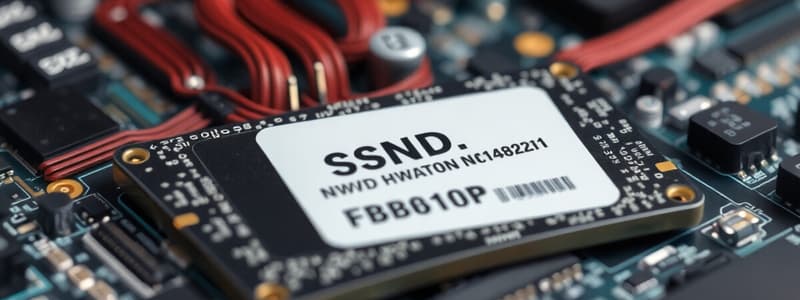Podcast
Questions and Answers
Care este principala diferență dintre SSD-uri și HDD-uri?
Care este principala diferență dintre SSD-uri și HDD-uri?
- SSD-urile utilizează memorii magnetice.
- SSD-urile au platane în mișcare.
- HDD-urile oferă viteze de citire mai rapide.
- SSD-urile stochează datele folosind circuite integrate. (correct)
Ce tip de memorie este folosită predominant în SSD-uri?
Ce tip de memorie este folosită predominant în SSD-uri?
- EEPROM
- NAND Flash (correct)
- SRAM
- DRAM
Care dintre următoarele tipuri de NAND flash oferă cea mai bună performanță și durabilitate?
Care dintre următoarele tipuri de NAND flash oferă cea mai bună performanță și durabilitate?
- SLC (correct)
- QMLC
- TLC
- MLC
Ce reprezintă termenul de 'latency' în contextul SSD-urilor?
Ce reprezintă termenul de 'latency' în contextul SSD-urilor?
Ce aspecte influențează performanța SSD-urilor în timpul transferului de date?
Ce aspecte influențează performanța SSD-urilor în timpul transferului de date?
Ce este un algoritm de wear leveling?
Ce este un algoritm de wear leveling?
Care este principalul beneficiu al unei latențe reduse în SSD-uri?
Care este principalul beneficiu al unei latențe reduse în SSD-uri?
Ce reprezintă 'endurance' în contextul SSD-urilor?
Ce reprezintă 'endurance' în contextul SSD-urilor?
Cum afectează tipul de celule NAND flash performanța SSD-ului?
Cum afectează tipul de celule NAND flash performanța SSD-ului?
Flashcards
SSD (Solid State Drive)
SSD (Solid State Drive)
Un dispozitiv de stocare a datelor care utilizează circuite integrate pentru stocare, diferit de hard disk-urile tradiționale.
NAND flash
NAND flash
Tipul principal de memorie flash utilizat în SSD-uri pentru stocarea datelor.
Viteză de transfer (SSD)
Viteză de transfer (SSD)
Mărimea vitezei de citire și scriere a datelor dintr-un SSD, măsurată în MB/s sau GB/s.
Latență (SSD)
Latență (SSD)
Signup and view all the flashcards
SLC, MLC, TLC (NAND Flash)
SLC, MLC, TLC (NAND Flash)
Signup and view all the flashcards
Uniformizare utilizare (Wear Leveling)
Uniformizare utilizare (Wear Leveling)
Signup and view all the flashcards
Capacitate (SSD)
Capacitate (SSD)
Signup and view all the flashcards
Viteză de citire/scriere secvențială
Viteză de citire/scriere secvențială
Signup and view all the flashcards
Viteză de citire/scriere aleatoare
Viteză de citire/scriere aleatoare
Signup and view all the flashcards
Durată de viață (Endurance)
Durată de viață (Endurance)
Signup and view all the flashcards
Study Notes
SSD Storage
- Solid-State Drives (SSDs) store data using integrated circuits, unlike traditional hard disk drives (HDDs) which use spinning platters.
- SSDs utilize flash memory, typically NAND flash, for data storage.
- SSDs offer faster read and write speeds compared to HDDs, leading to quicker boot times and application launches.
- Their lower latency also contributes to improved overall system performance.
- SSDs are generally more resistant to physical shock than HDDs.
NAND Flash Technology
- NAND flash memory is the primary storage medium in SSDs.
- NAND flash is based on floating-gate transistors.
- Data is stored electronically, as opposed to magnetically in HDDs.
- NAND flash memory comes in various types including SLC, MLC, TLC, etc.
- Differences in these types relate to cell size, storage density, and performance capabilities. SLC (Single-Level Cell) offers the highest performance and endurance but is more expensive.
- TLC (Triple-Level Cell) provides greater storage density and lower cost, but with slightly lower performance and endurance.
SSD Performance Metrics
- Transfer speeds (read/write): Measured in megabytes per second (MB/s) or gigabytes per second (GB/s). Higher speeds indicate faster data access.
- Latency: The time it takes for data to be accessed. Lower latency equates to quicker responses.
- Throughput: The rate at which data can be transferred over a period of time.
- Sequential read/write: The rate of data transfer in large, continuous blocks. Useful for large file transfers.
- Random read/write: The rate at which data can be accessed from various locations. Crucial for accessing files scattered across the drive.
- Endurance: The number of read/write cycles a drive can perform before degrading in performance or failing.
- Capacity: The total amount of storage space available, often measured in gigabytes (GB) or terabytes (TB).
- Power Consumption: The amount of power required to operate the drive. Lower power consumption can lead to greater energy efficiency.
Wear Leveling Algorithms
- Wear leveling is crucial for SSD longevity.
- NAND flash cells degrade over time with repeated write operations.
- Wear leveling algorithms aim to spread write operations evenly across all flash cells.
- This prevents specific cells from being used excessively, extending the lifespan of the SSD.
- Various algorithms exist to achieve this balancing, including using a mapping table to distribute writes across all NAND blocks.
- Advanced techniques like dynamic wear leveling adapt to changing access patterns and predicted block usage.
- Newer algorithms also focus on predictive maintenance to identify failing cells and proactively manage write operations to minimize the impact on system performance.
- These processes contribute to the reliability and longevity of the SSD.
Studying That Suits You
Use AI to generate personalized quizzes and flashcards to suit your learning preferences.




